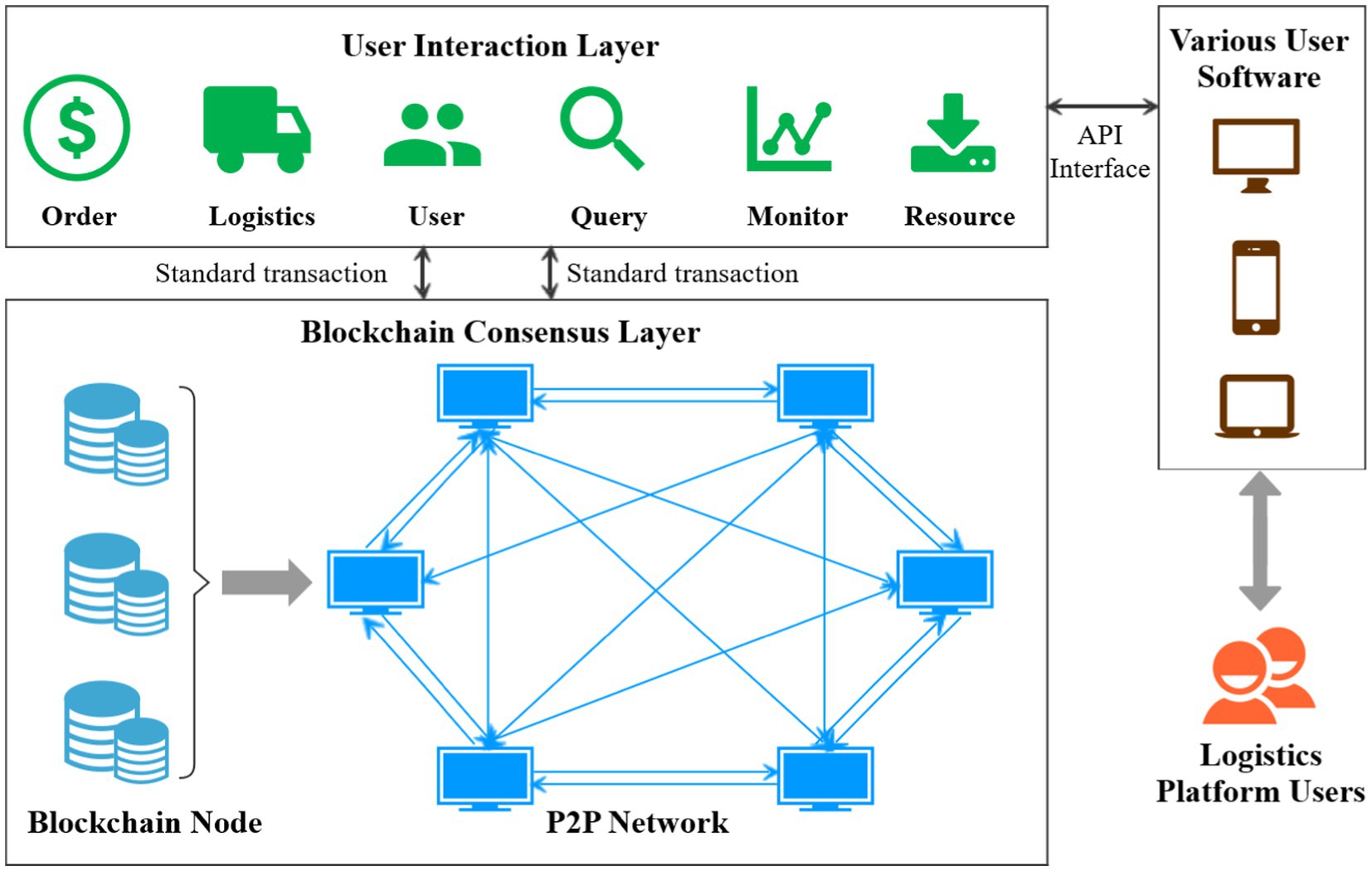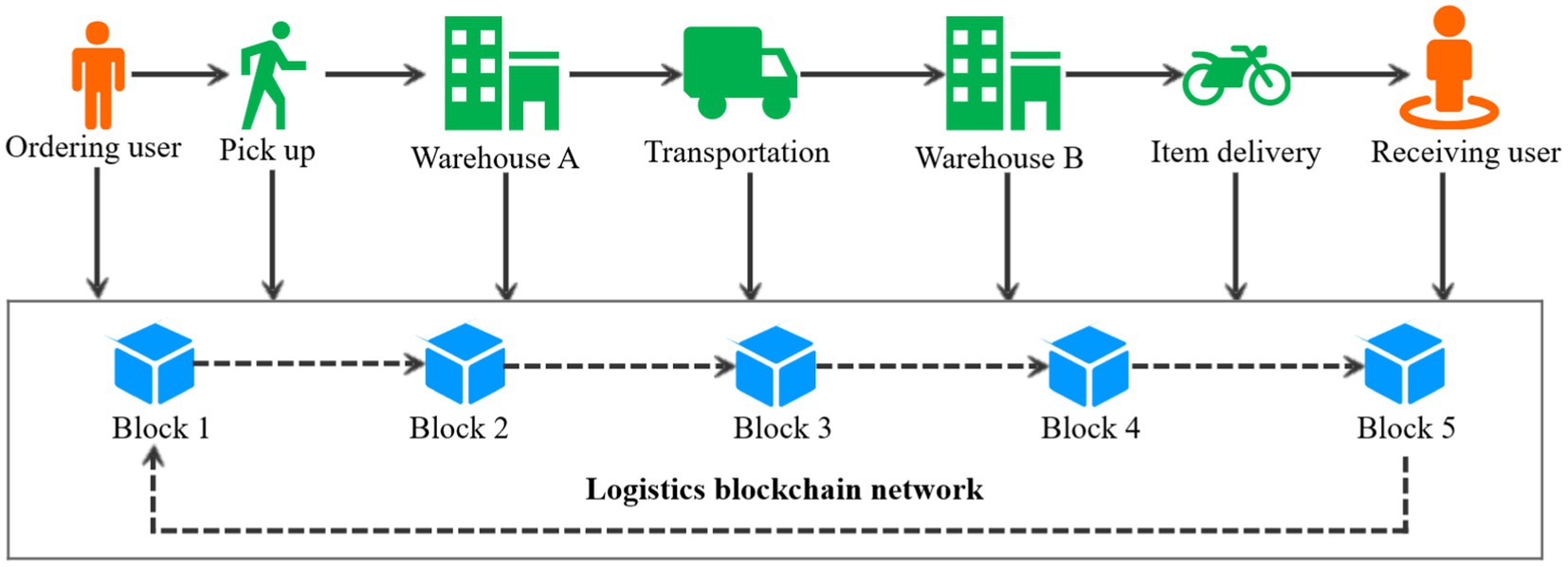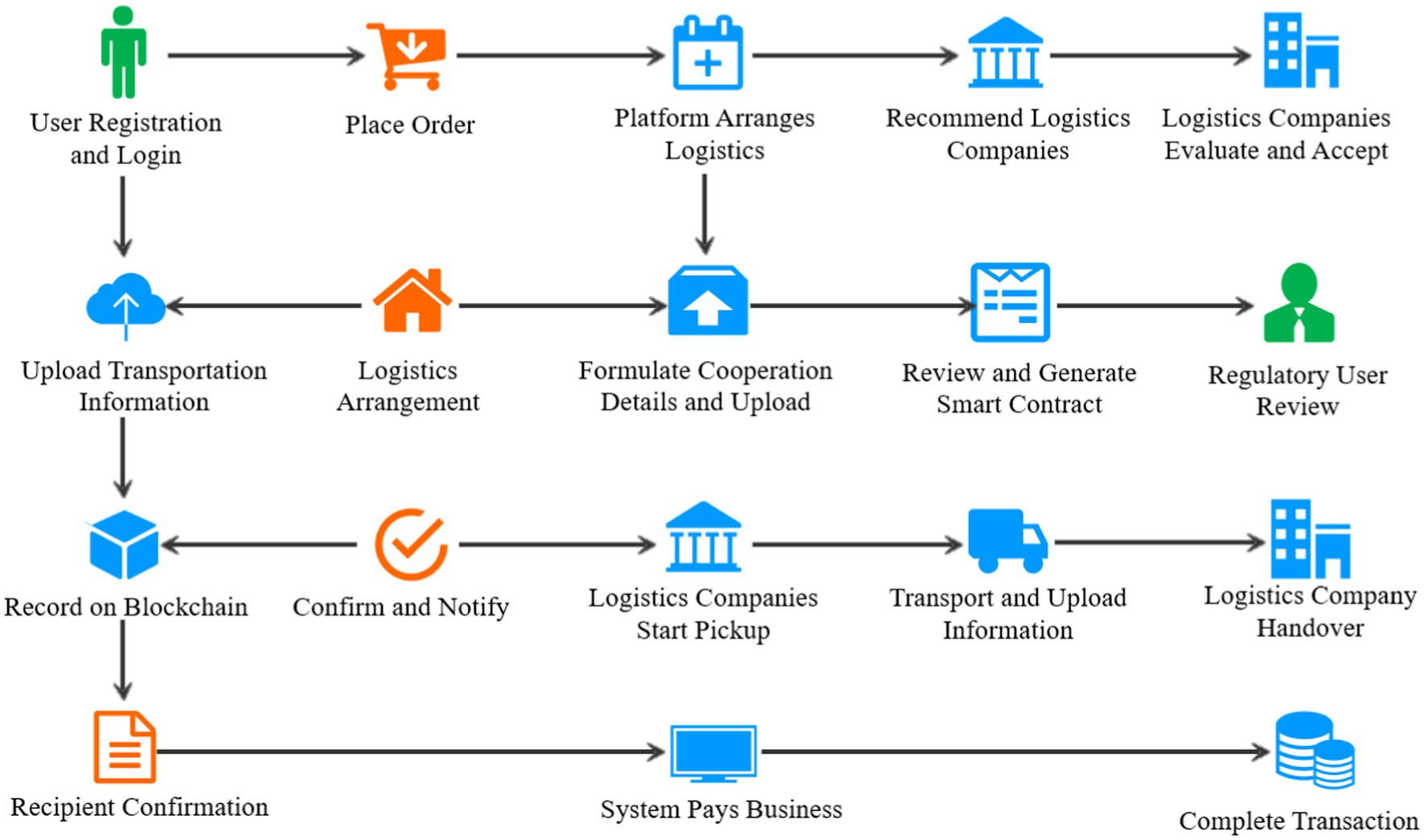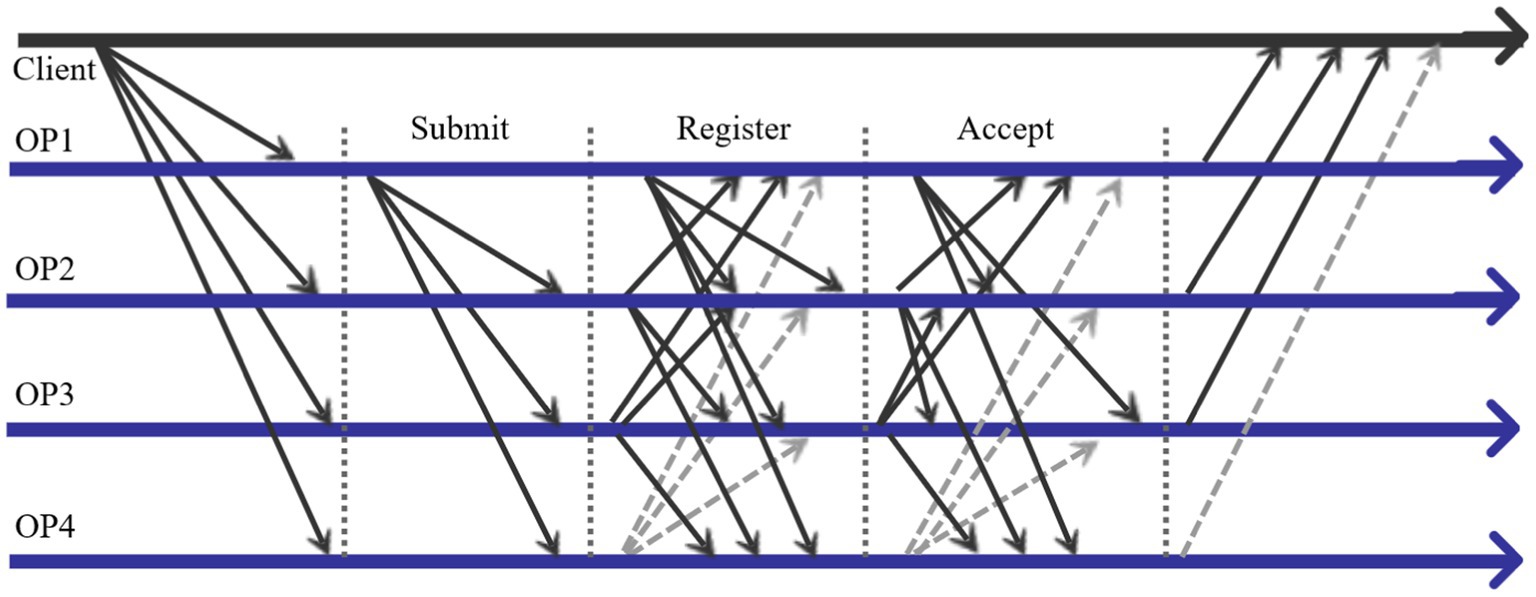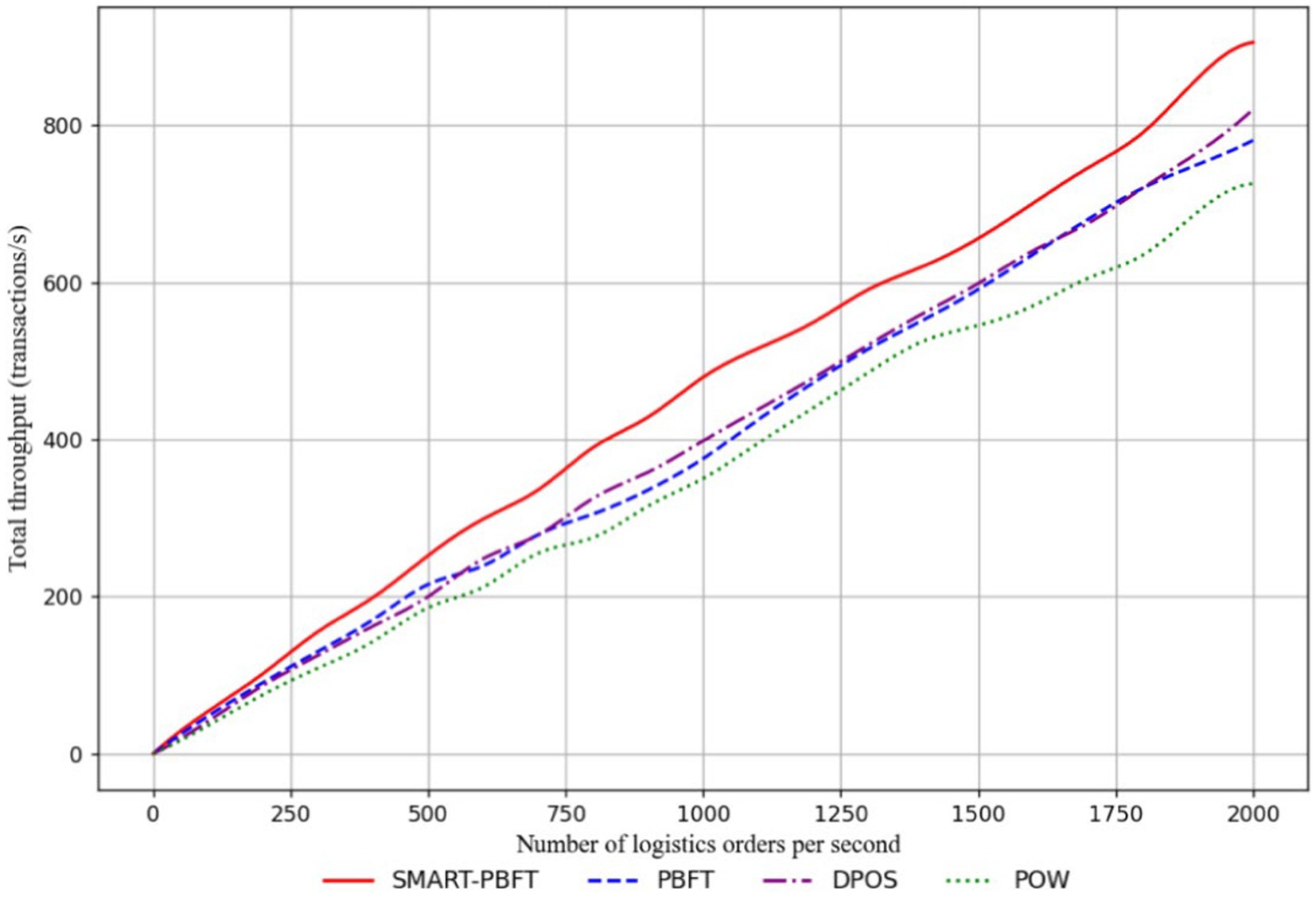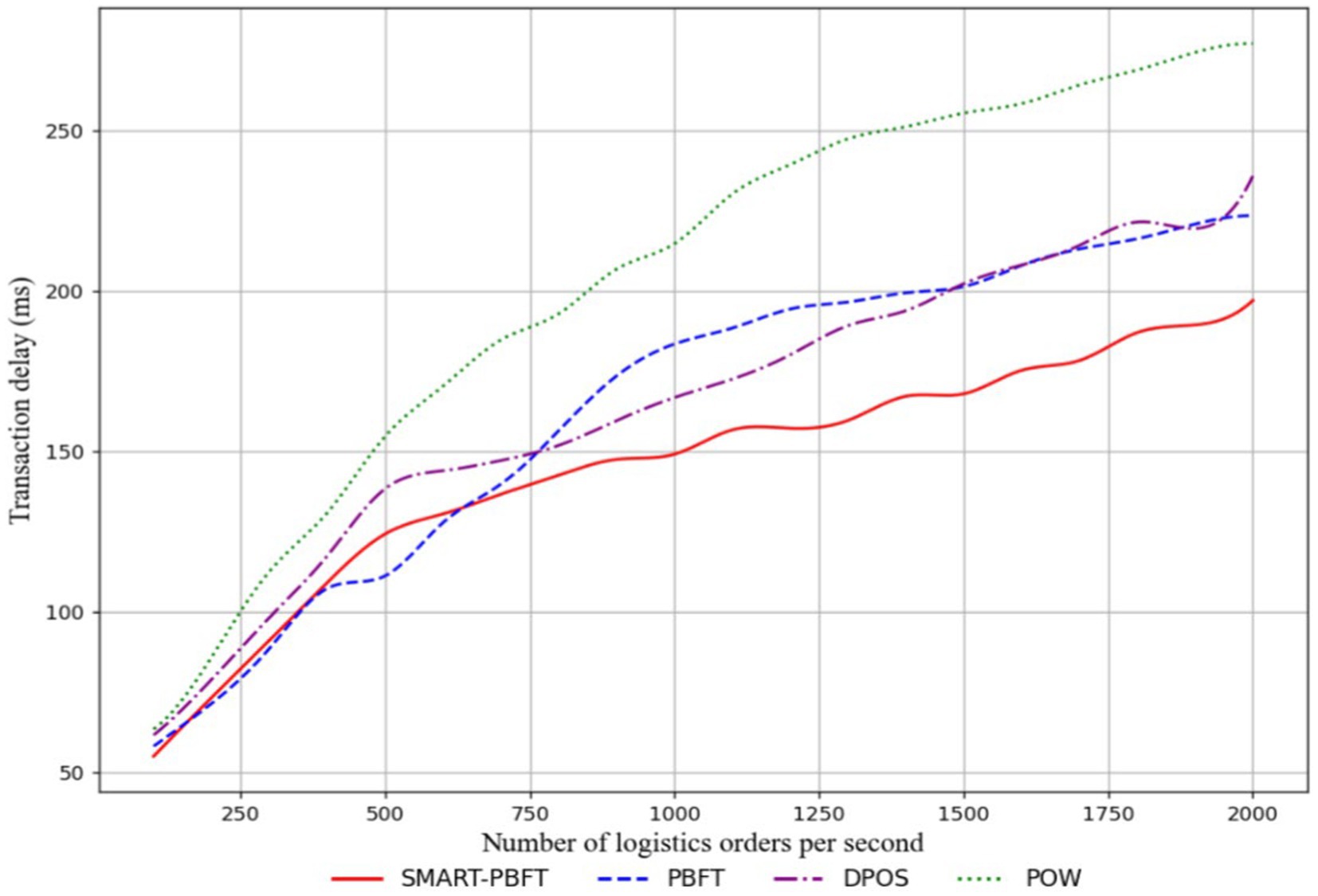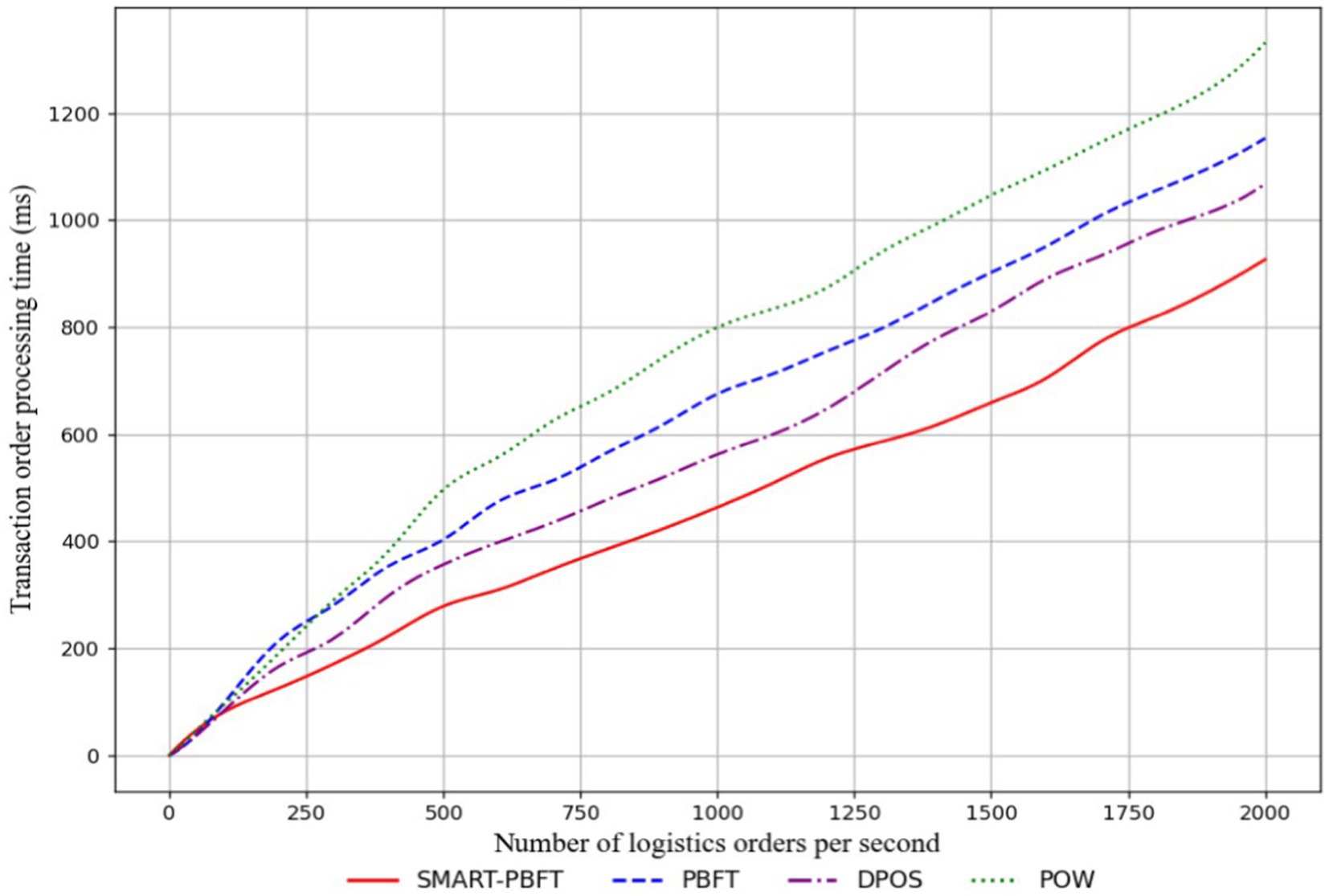- 1Department of Civil Engineering, Faculty of Engineering, Universiti Malaya, Kuala Lumpur, Malaysia
- 2Department of Logistics Engineering, Faculty of Airport, Jiangxi Flight University, Nan Chang, China
- 3Department of Mechanical Engineering, Faculty of Engineering, Universiti Malaya, Kuala Lumpur, Malaysia
- 4Centre for Transportation Research, Universiti Malaya, Kuala Lumpur, Malaysia
As a high-value agricultural product, the cold chain logistics management of Gannan navel oranges has global significance. Especially in Africa and Europe, food safety and supply chain quality are critical issues. However, the existing Gannan navel orange logistics information management system relies on traditional databases and information systems, with insufficient data sharing and transparency, affecting the overall coordination of the supply chain and customer satisfaction. In addition, the traditional system is vulnerable to hacker attacks and malicious tampering of data by insiders, resulting in serious economic losses and reputation damage. So the blockchain platform constructed in this study improves the transparency and traceability of logistics data through the SMART-PBFT algorithm of the alliance chain, which optimizes the logistics management process, improves the quality of logistics services, and reduces operating costs. It improves the logistics efficiency and data transparency of local agricultural products, and also provides a demonstrative case for the cold chain management of other high-value agricultural products around the world, with broad application potential and reference value.
1 Introduction
Gannan navel oranges plays an important role in the domestic and overseas markets in China, which has the large output and high market demand, and the significant impact on local economic development. As a perishable agricultural production, it has extremely stringent requirements for temperature control and timeliness in logistics. The existing logistics management system has deficiencies in data transparency and information sharing, which easily leads to poor collaboration in various links of the supply chain, affecting logistics efficiency and product quality (Rui and Yang-Cai, 2022; Chen et al., 2021). The current cold chain logistics management relies on manual operations and multi-layer approval. From the order creation, logistics company selection, and transportation arrangement to final sign-off, every link requires manual participation, which increases the possibility of errors and delays. Traditional logistics systems lack real-time data monitoring and updating capabilities and the lag of logistics information is serious, which is impossible to obtain the logistics status and environmental parameters (such as temperature, humidity, etc.) of navel oranges in real time during transportation (Ye et al., 2024; Zhang et al., 2022). The distributed ledger technology of blockchain technology can ensure that all participating nodes can access and verify logistics data, so how to improve the efficiency of the logistics platform for Gannan navel oranges by using the blockchain technology is important. Because the supply chains of high-value agricultural products in other regions can also learn from this platform, especially in Africa and Europe, where food safety and supply chain quality are also crucial (Hou et al., 2023).
Some scholars have achieved some achievements in combining blockchain technology with the logistics information platforms. Rožman et al. (2019) used a distributed node network to decompose the modern supply chain into smaller independent parts, which allows users to add their nodes or expand existing nodes, provides an alternative way to deal with the complexity of the modern supply chain. Barenji and Montreuil (2022) defined and developed the concept of proof of delivery (PoD) based on smart contracts, designed and discussed blockchain asset-sharing services, and proposed a blockchain-enabled hyperconnected logistics platform. El Midaoui et al. (2021) proposed a blockchain logistics information management method that uses the distributed ledger to consider all required data, including the specific conditions of urban areas, in addition to the configurable IoT-based system and provides an open data platform for shareholders and consumers. Ni and Irannezhad (2024) used the Hyperledger Fabric blockchain network to simulate the shipping logistics process, proposed a proof-of-concept model, and implemented the RAFT consensus mechanism to illustrate the automation and self-execution characteristics of smart contracts and transactions between various logistics participants.
Liao and Wang (2018) adopted the concentric value circle (CVC) model to determine the need for using blockchain technology in ICE logistics and developed an open, automated and transparent platform. Li et al. (2018) combined a unique responsibility relay system and evaluation reporting mechanism to achieve the transparency and consistency of charity logistics data, which establishes a social welfare evaluation model for charity material donations based on the classical network maximum flow algorithm, and built an innovative charity logistics platform based on blockchain technology. Wang et al. (2021) constructed a logistics service satisfaction evaluation index system, designed a calculation method for the amount of satisfaction information for different expected data types, and built a multi-objective optimization model for the blockchain platform logistics service transaction matching. Li et al. (2019) introduced the gateway technology, multi-dimensional workflow models, and resource blockchain. It proposed a blockchain-based workflow operating system (Bc-WfOS), which centrally shares heterogeneous logistics resources with different customers, solve the problem that logistics resources are severely dispersed and cannot be centrally managed. Liu et al. (2021) proposed a logistics service enterprise platform based on the multi-agent mechanism and blockchain. It is decentralized through the point-to-point communication provided by blockchain and centralized through a multi-agent system, thereby providing a perfect logistics mechanism to protect corporate interests.
Although the above studies has some achievements in the logistics information management, its application in the cold chain logistics information management of Gannan Navel Orange still has some shortcomings. Most studies are aimed at self-operated logistics platforms, but there is a lack of unified standards and interoperability between different platforms. If different participants in the supply chain adopt different blockchain platforms, it will lead to an information island effect, which affects the overall coordination and efficiency of the supply chain. In addition, the public blockchain ledger makes all transaction information viewable, which leads to the leakage of commercially sensitive information. When the network scale expands, the transaction processing speed and efficiency of the blockchain will decrease, which increases latency and reduces throughput. Although Liu et al. (2021) proposed a five-layer blockchain and an IoT-based intelligent tracking and tracing platform to provide a decentralized traceability solution in the pharmaceutical supply chain, but the large amount of data generated in the logistics process needs to be processed and stored. The scalability and storage capacity of the blockchain network will become a bottleneck, which is difficult to find a balance between achieving data transparency and privacy protection, and the interests of all parties are easily damaged. So this study proposed a cold chain logistics information platform for Gannan navel oranges based on blockchain technology. Through the distributed ledger technology of blockchain, the transparency and traceability of logistics data were enhanced, thereby improving the collaborative efficiency and food safety of the entire supply chain.
2 Models design
The Gannan navel orange cold chain logistics information platform based on the blockchain technology can solve the problems of insufficient transparency, limited data sharing, and low collaboration efficiency in the current logistics management system. The current system relies on the traditional databases and information systems, which are usually maintained independently by various logistics companies. There is a lack of unified standards and cross-platform interoperability, which decreases the trust between various links in the supply chain, decreases the customer satisfaction with logistics services and impacts the collaboration efficiency between enterprises. The difference from the existing system is that the blockchain logistics platform proposed in this study realizes data interoperability and collaboration between systems of different logistics companies through blockchain technology, overcomes the problem of information islands in traditional systems, and ensures efficient collaboration in various links of the supply chain. It performs better in data security and reliability, and provides the real-time logistics status monitoring and abnormal situation response capabilities.
In terms of platform design, this study uses the blockchain technology to improve the original information transaction model so that the transaction information is stored in the chain. Transactions are conducted in the blockchain, and multiple parties participate and maintain it together. It is different from the fully open and decentralized model of cryptocurrency, industry-level information platform, which needs to protect the privacy of participating enterprises while uploading real information (Li et al., 2020; Yang et al., 2022). Therefore, this system adopts the alliance chain architecture and designs a multi-centralized architecture based on the alliance chain, which is conducive to giving full play to the advantages of blockchain technology in data immutability, easy traceability and multi-party verification. It has advantages in other features, such as certificate maintenance and improving the performance and efficiency of the platform. It is divided into the application interaction and blockchain consensus layer, as shown as Figure 1.
2.1 Application interaction layer
The platform proposed in this study serves the cold chain logistics management process of Gannan navel oranges. It starts with the generation of orders, including the logistics company selection, transportation arrangement, temperature monitoring, etc. Each link requires the efficient collaboration and information sharing to ensure the quality and freshness of navel oranges during transportation. This study takes logistics companies as the main body and provides the professional logistics services for shippers and consignees. The platform does not participate in the sale of navel oranges, but provides logistics agency services to the platform’s customers through cooperation between logistics companies. It mainly provides pickup, warehousing, transportation and distribution services, and its core functions are logistics services and order management, as follows.
2.1.1 Logistics services
The platform’s logistics service includes the following stages: first, the individual users place orders on the platform and upload the item information, which is waiting for the platform to assign tasks to logistics companies. The logistics company receives the delivery task from the platform, confirms the order, and designates employees to pick up the items. After the item is received, the information of items are confirmed. The platform will help individual users create a logistics transaction order and order package, which includes the transaction ID, order time, logistic company, and company signature. After the individual user confirms the order information, the order is officially generated and uploaded to the blockchain. Then, the logistics company puts the received goods into the warehouse and generates the information to the blockchain, which includes the goods’ entry and exit photos, entry and exit time, safety supervisor, and sorting supervisor. When the goods arrive at various logistics storage centers, the logistics company will check with the previous logistics company. The orders at the storage center are confirmed and signed. When the logistics information are updated in real-time, the individual users can understand the transportation status of navel oranges in real-time. Finally, after the items are transported to the warehouse close to the recipient through logistics, the information of goods are confirmed first. The local logistics company staff will be also designated to deliver the goods for the recipient’s door. After the recipient receives the goods, the delivery staff takes a photo of the product, and records the pickup time and signature of the recipient. After recording the information, the delivery person generates an order and uploads it to DMT-Chain. The recipient confirms it, so the navel orange logistics process is completed. Figure 2 shows the blockchain logistics service process.
2.1.2 Order service
The order transaction is first initiated by the individual user and accepted by the corporate user. During the entire transaction process, the supervisory user can monitor the entire transaction process in real-time and resolve transaction disputes (Helo and Shamsuzzoha, 2020). Figure 3 shows the transaction process of the entire order. First, the individual user registers and logs in the platform to place an order for the delivery service. After the order is placed, wait for the platform to arrange logistics and transportation. Then, the platform will arrange the delivery according to the order. It will recommend three most suitable logistics companies for the user to choose. During the transportation process, multiple logistics companies may be required. After confirmation, the platform will send a system message to these companies to ask whether they are willing to participate in the delivery service. After receiving the order, the companies will evaluate its current transportation and warehousing capabilities. After the evaluation, the platform will reply to the message. After confirming participation in the navel orange delivery service, the platform will upload information on the transport personnel, warehouse and transport vehicles responsible for the transportation of the goods. Logistics companies can cooperate on the platform to formulate cooperation details, which includes transportation routes, transport vehicles and personnel information. After both parties confirm that everything is correct, the details of the cooperation will be uploaded to the platform for review.
After receiving the confirmation of participation and relevant transportation arrangements from the enterprise user, the smart contract is generated based on the contract content of the operation, and a message is sent to the supervisory user, who will record the message in the local log. Supervisory users can review the contract content, mainly to check whether there is any violation of laws and regulations in the transportation of navel oranges. After receiving the smart contract generated by the contract content, the user will reply to the platform with a confirmation message. After receiving the confirmation receipt from the supervisory user, the platform will officially record the transaction in the blockchain. The blockchain also sends a message to the transport company to notify them to start door-to-door pickup and transportation (Irannezhad, 2020). Finally, during the transportation of navel oranges, enterprise users will upload the inbound and outbound information of the items after the items arrive at the relevant storage nodes. The next transport company will check the information and the responsible person’s information, and the transportation process will be carried out according to the contract. When the delivery is in hand, the transport company staff will take photos of the items and the recipient’s signature. The recipient will confirm the transportation process for all items. When the process is completed, the system will automatically pay the enterprise according to the smart contract.
2.2 Blockchain consensus layer
The blockchain system is essentially a shared ledger maintained in the distributed system. The task of the consensus mechanism is to ensure that the status and data of all nodes in the distributed system are consistent. This platform is based on SMART-PBFT (Byzantine Fault Tolerant State Machine Replication Algorithm) (Distler, 2021). The blockchain consensus mechanism is a modular implementation based on the PBFT algorithm, which enhances the reliability and modularity of the PBFT algorithm. It modifies the PBFT algorithm according to the needs of the cold chain logistics system. The method is optimized as follows.
2.2.1 Consensus mechanism design
The SMART-PBFT platform proposed in this study is based on the alliance chain architecture and is partially decentralized. It is very different from the traditional blockchain system in all aspects of other cryptocurrency application scenarios. Therefore, the consensus mechanism of this platform is based on the deterministic consensus algorithm rather than the probabilistic consensus algorithm (Wang et al., 2020). The identity management and access control are added to the outer layer of the blockchain network, and each node has a third party. The alliance blockchain verifies the real-world identity of each party, and each node joining the network is approved and endorsed by the members of the alliance blockchain chain. Therefore, the SMART-PBFT platform can completely abandon the proof-of-work mechanism or similar mechanisms such as Proof of Stake (POS) (Deuber et al., 2020) and Proof of Elapsed Time (POET) (Pal and Kant, 2021) to ensure that nodes comply with the blockchain. The motivation proof mechanism of the network rules selects a deterministic consistency algorithm, which designs simplifies the consensus mechanism process and reduces node hardware performance requirements. It also does not require the internal incentive strategy of the traditional blockchain system. Because the consensus nodes in the alliance chain are all verifiable, participants are often bound by business rules. If abnormal situations occur, regulatory mechanisms and governance measures can be enabled outside the network. There is no need to set up incentive mechanisms within the network to track penalties or further governance measures. This principle can simplify the consensus mechanism and focus blockchain node resources on the processing of core data, thereby improving system performance. Finally, the consensus mechanism of the platform has byzantine fault tolerance. Because it targets the logistics industry, which is a typical multi-party participation application scenario, the system has many types of participating members and a wide span. From the core nodes operated by logistics companies to the general, basic clients used by express delivery users and couriers, have a wide range of transaction types and the possibility of malicious sabotage. Therefore, its consensus mechanism is designed with byzantine fault tolerance, which can filter out most malicious transaction data at the bottom of the system. This can save the cost of subsequent accountability and correction of transaction data.
2.2.2 Optimize the leader election mechanism
In the process of leader node confirmation, a point ranking method is introduced to determine the election order. In the SMART-PBFT platform, all nodes added to the blockchain network are authenticated, and their data processing capabilities are evaluated based on the authentication process (Zhaofeng et al., 2020). The small node allocates the original score to each node in the blockchain network and distributes the nodes in the blockchain network according to the score. It is divided into the leader node queue and the standby node queue with a total score of 150 points. When the points are greater than 120 points, the node will be added to the leader node queue for rotation, and the nodes with less than 120 points will enter the standby queue. When an error occurs in a node in the blockchain network (The number of nodes is less than 20 k, k is the total number of nodes in the blockchain network), the current leader node score is reduced by 15 points and enters the candidate node queue for ranking. The node with the highest score in the leader node queue is selected to become the new leader node to participate in the consensus. Each node on the SMART-PBFT platform completes a data consensus, the node points will increase. The node points above 120 points will increase by 0.1 each time, the node points between 100 and 120 points will increase by 0.1 each time, and the node points below 100 points will increase by 0.1 each time. Each time the score increases by 0.15, the highest score of the node in the leader node queue is 150, and the score will not increase after reaching 150. As shown in Formula 1:
In Formula 1, it represents the integral after the node executes the consensus, represents the integral before executing data consensus. When the points calculation rule is executed for the first time, .
2.2.3 Optimize error handling mechanism
The SMART-PBFT algorithm uses the multi-threading technology to run the error handling mechanism. The parallel computing can improve its efficiency, but it will increase the hardware resource requirements of the nodes and is not suitable for the application of this study. So this study designs all nodes to use the atomic broadcast mode when executing the consensus algorithm. After the error occurs, the client is not processed but is reported to re-initiate the transaction (Erös, 2022), which is supposed to place in the large public chain. In that case, the cross-regional network heterogeneity will cause the erroneous transaction to be delayed for a long time, affecting the efficiency of the entire blockchain network. However, under the alliance chain architecture, the transaction error rate is low, and the underlying network is relatively controllable, which is conducive to simplifying the process and speed up the execution of the consensus algorithm. Its average time to reach consensus is much lower than that of existing mainstream consensus algorithms such as POW and POS. The communication mode of the SMART-PBFT algorithm is shown in Figure 4.
In the improved algorithm process, the node is selected in the blockchain network to become the leader node through the random algorithm. The client sends the request to the leader node, which is responsible for broadcasting the request to all other replica nodes. All nodes process the request and send the processing results. The leader node broadcast process consists of three phases: the pre-preparation phase, the preparation phase, and the submission phase. It prepares and commits phases to ensure that requests are sent in the correct order. Under this circumstance, the confirmation request is sequence-preserving and the specific process is as follows:
1. Pre-prepare phase: The leader node assigns a submission number to the request received from the client and then sends a pre-prepared message << pre-prep, view, m, sum >, mes > to each replica node, where mes is the client’s request message, sum is the summary of the message.
2. Preparation phase: After receiving the pre-prepare message, the replica node independently checks the legitimacy of the message. If the check passes, it sends a preparation message to other nodes, brings its own ID information and receives preparation messages from other nodes. The node that receives the prepared message also performs a validity check on the message. If the verification passes, the prepared message is written into the message in the log. The node receives broadcast messages from neighboring nodes and waits for at least verified messages before entering the ready state.
3. Commit phase: The node that enters the preparation phase broadcasts a commit message to the entire network, telling other nodes that a certain commit has been made. Under the organization of the current leader node, it is already ready. The node continues to receive application messages from adjacent nodes and waits for at least one application message to be collected. Otherwise, after the timeout, the reply notification of order failure is sent to the client. After any node has collected at least application messages, it will approve the submission request and use the execution data of the request to update the new node status.
3 Experimental design and results
3.1 Experimental environment
This study uses the Hyperledger Fabric v2.1 framework (Sato et al., 2021), the system was Ubuntu 17.2.1, and the CPU was Intel Corei5 3.7 GHz, 32 GB memory, and uses the built-in monitoring service of docker to detect the CPU occupancy rate during operation. The simulation system platform consists of five sorting node hosts, six Kafka node hosts, three zookeeper node hosts, and 30 service node hosts. In order to evaluate the system’s throughput and meet the needs of logistics companies, this study will establish offline nodes and simulate the process of data collection to better evaluate the performance of the system. It records the transportation operation of navel oranges, information collection, client, simulation execution, etc. It also records the system response time and CPU occupancy rate and adjusts according to the changes in the submission rate (Yi et al., 2020).
3.2 Experimental results
In the previous section, this study introduced the technical implementation of the SMART-PBFT algorithm in detail. To further verify the effectiveness of the algorithm, it will present the experimental results and discuss how these results reflect the performance of the algorithm in practical applications. The SMART-PBFT platform will compares with the platforms built by Practical Byzantine Fault Tolerance (PBFT) (Chen et al., 2022), Delegated Proof of Stake (DPOS) (Saad and Radzi, 2020), and Proof of Work (POW) (Lasla et al., 2022). The result is as follows.
3.2.1 Platform throughput
Figure 5 shows the throughput of the platforms built by each algorithm. The average throughput of the platform built by the SMART-PBFT algorithm is 482.90 transaction/s, which is 15.65, 13.84, and 27.00% higher than that of the platforms built by PBFT, DPOS, and POW. As the number of nodes in the blockchain network increases, the throughput is growing slowly, but the average increase per 100 nodes of SMART-PBFT is 44.84 transaction/s, which is 16.20, 9.34, and 23.49% higher than another three platforms. The PBFT algorithm is relatively complex, and each node needs to perform a large number of message exchanges and verifications, resulting in low efficiency of the system when processing a large number of transactions. Although the DPOS algorithm improves efficiency by electing representative nodes (verification nodes) in actual operation, the election and verification process of representative nodes still takes a certain amount of time, resulting in limited overall throughput of the system. The POW platform relies on calculating complex mathematical problems to compete to generate new blocks, resulting in a very slow system processing of transactions and a large amount of computing resources wasted on hash operations. The SMART-PBFT algorithm reduces the consensus mechanism process, allowing the platform to process a large number of transaction orders more efficiently, so the throughput is higher than that of the platforms and can meet the requirements of the cold chain logistics information platform for the consensus algorithm.
3.2.2 Network latency
Figure 6 shows the network delay of the platform built by each algorithm. The average network delay of the platform built by the SMART-PBFT algorithm is 144.77 ms, which is an increase of 13.27, 14.01, and 41.02% compared with the platform built by the PBFT, DPOS, and POW algorithms. The consensus process of the PBFT algorithm involves multiple stages of message delivery and verification. When the number of nodes increases, communication overhead and processing time increase significantly, resulting in high latency. The election and voting process of the DPOS algorithm representative node adds additional time overhead, and the delay problem is more obvious when there are malicious nodes or network delays. The POW algorithm requires a large amount of computing resources and time to solve the hash problem to generate new blocks, resulting in a very long confirmation time for each transaction. The SMART-PBFT algorithm reduces unnecessary internal incentive strategies and complex verification steps, reduces the hardware performance requirements of nodes, and speeds up consensus. Compared with the probabilistic consensus algorithm, its deterministic algorithm can reach consensus more quickly, handle the problem of byzantine nodes well and make the system more secure and stable.
3.2.3 Transaction order processing time
Figure 7 shows the transaction order processing time of the platform built by each algorithm for different transaction quantities. The average platform processing time built by the SMART-PBFT algorithm is 491.27 ms, which is 37.17, 21.81, and 58.28% less than the platform built by the PBFT, DPOS, and POW algorithms. Each node of the PBFT algorithm platform needs to exchange messages and verify with all other nodes; as the number of nodes increases, its communication overhead increases significantly. The DPOS algorithm platform requires multiple rounds of voting and verification when processing transactions, which increases transaction processing time. The POW algorithm platform relies on calculating complex mathematical problems to compete to generate new blocks. This process requires a large amount of computing resources and time, resulting in a relatively long time for each transaction confirmation. The SMART-PBFT algorithm achieves efficient message delivery and verification processes through an improved byzantine fault-tolerant mechanism, which reduces the complexity and time overhead in the consensus process, as well as transaction processing time.
3.2.4 Node resource consumption
Figure 8 shows the node resource consumption of nodes for different transaction numbers for platforms built by various algorithms. The average CPU occupancy rate of the SMART-PBFT algorithm platform is 43.67%, which is 34.18, 19.59, and 33.05% less than the PBFT, DPOS, and POW algorithm. Its average memory consumption is 3.60 GB, which is 13.96, 24.93, and 26.98% less than another three algorithms. Each node of the PBFT algorithm platform needs to conduct multiple rounds of message transmission and verification with all other nodes, which increases the burden on CPU and memory. The DPOS algorithm requires frequent verification and voting and both rounds of elections and voting will increase the communication and computing volume between nodes, resulting in increased resource consumption. The POW algorithm relies on solving complex mathematical problems to compete with the generation of new blocks, which requires a lot of computing resources, resulting in very high CPU and memory consumption. The SMART-PBFT algorithm efficiently completes the consensus process through three stages: pre-preparation, preparation, and submission, reducing unnecessary message transmission and computing overhead. Its multi-threading technology and parallel computing improve efficiency, reduce the bottleneck of single-thread processing, and make CPU and memory resource utilization more efficient than another three algorithms.
4 Discussion
The SMART-PBFT algorithm proposed in this study improves efficiency and security, and reduces computational complexity by simplifying the consensus process and reducing internal incentive strategies. Although Rožman et al. (2019) proposed a distributed logistics platform based on blockchain and the internet of things from other perspectives, the system throughput and processing efficiency are relatively low when processing a large number of transaction orders. So the SMART-PBFT algorithm is more suitable for cold chain logistics scenarios that require the efficient processing of large transactions. Although it shows superior performance to other algorithms (PBFT, DPOS, and POW) and platforms, it has some shortcomings. For example, the throughput of the SMART-PBFT platform in the above experiments is superior to other three algorithm platforms, but the software and hardware configurations of the platforms deployed by each algorithm are the same. The choice of specific hardware configuration and experimental environment will affect the throughput differences observed by the SMART-PBFT, PBFT, DPOS, and POW. The SMART-PBFT algorithm performs well in the multi-threaded processing and parallel computing, so the high-performance hardware configuration (such as multi-core CPU and large-capacity memory) used by SMART-PBFT algorithm can better play its advantages, which shows better throughput than other algorithm platforms. On the contrary, the PBFT, DPOS, and POW algorithms have different utilization efficiencies of computing resources. The POW algorithm is more dependent on the computing power; the DPOS algorithm is affected by the hardware configuration during the node election and verification process. In order to verify the universality of these results in subsequent research, these algorithms need to be further tested in the variety of hardware environments to ensure the reliability of the conclusions.
In addition, the SMART-PBFT algorithm reduces the network latency by reducing the internal incentive strategies and simplifying the complex verification steps. Traditional blockchain consensus algorithms, such as POW and DPOS, often rely on the complex calculations or multiple rounds of election voting, which increases the computing overhead of the system and prolongs the time between nodes. In contrast, the SMART-PBFT algorithm simplifies the verification process and reduces the use of internal incentive strategies by optimizing the consensus mechanism. It reduces the number of communications and data processing volume during the consensus process, which reduces the network latency. This improvement is especially noticeable in the environments with malicious nodes or high network latency. Traditional algorithms usually require the additional verification steps or protection mechanisms when faced with malicious nodes or network delays, which affect the overall performance of the system. The SMART-PBFT algorithm can effectively filter most malicious transaction data by introducing the Byzantine fault tolerance mechanism in the consensus process, which reduces the additional overhead caused by malicious nodes or network delays.
Finally, the SMART-PBFT algorithm significantly outperforms the PBFT, DPOS, and POW algorithms in the transaction processing time. Because the PBFT algorithm requires a large number of message exchanges and verifications between each node, the processing time is long. By optimizing the consensus process, the SMART-PBFT algorithm reduces unnecessary steps in the consensus process, which makes the entire process more efficient and reduces the transaction processing time. Compared with POW and DPOS algorithms, the SMART-PBFT algorithm reduces the complexity of decentralization to the certain extent. The POW algorithm relies on the complex mathematical calculations to generate new blocks, which requires a lot of computing resources. The DPOS algorithm involves the node election and voting processes, which adds the additional time overhead in the actual operations. It avoids these complex calculations and election processes through the partially decentralized alliance chain architecture, which shows the obvious advantages in transaction processing time. It also uses multi-thread processing and parallel computing technology, which enables the system to process multiple transaction requests at the same time. It also uses the atomic broadcast mode to process and restart the transactions to handle errors or abnormal transaction processes, which avoids the long-term transactions, time waiting and complex error correction steps.
5 Conclusion
This study proposes a Gannan navel orange cold chain logistics information platform based on blockchain technology, including the application interaction and blockchain consensus layer. The application interaction layer is the user interface and operation layer of the platform, including logistics services and order management, and it provides services such as pickup, warehousing, transportation, and distribution. The blockchain consensus layer uses the blockchain consensus mechanism of the alliance chain based on the SMART-PBFT algorithm, which adopts a deterministic consensus algorithm, optimized leader election, and error handling mechanism. Experimental results show that the platform built based on the SMART-PBFT algorithm is significantly better than the PBFT, DPOS, and POW algorithm platforms in terms of throughput, network delay, transaction order processing time, and resource consumption. It shows that the SMART-PBFT can maintain high throughput, low network latency, and resource consumption, which demonstrates its potential in cold chain logistics applications for Gannan navel oranges. It enables a more efficient consensus process and ensures security and stability in multi-party participation and complex transaction scenarios. It improves data transparency and traceability, optimizes logistics management processes, and enables logistics companies to automate many logistics management processes through smart contracts, which reduces the manual intervention, improving efficiency, and further reducing operating costs.
Data availability statement
The original contributions presented in the study are included in the article/supplementary material, further inquiries can be directed to the corresponding author.
Author contributions
XX: Visualization, Validation, Software, Resources, Methodology, Formal analysis, Data curation, Conceptualization, Writing – review & editing, Writing – original draft. YW: Writing – review & editing, Supervision, Resources, Project administration, Investigation, Funding acquisition, Conceptualization. SK: Writing – review & editing, Supervision, Resources, Funding acquisition, Conceptualization. SM: Data curation, Methodology, Validation, Writing – review & editing.
Funding
The author(s) declare that financial support was received for the research, authorship, and/or publication of this article. This work was supported by Education and Technology Project of Jiangxi Provincial Department of Education, China—Fund Project Name: Establishment of Gannan Navel Orange Cold Chain Logistics Information Platform Based on Blockchain Technology (GJJ2210503).
Conflict of interest
The authors declare that the research was conducted in the absence of any commercial or financial relationships that could be construed as a potential conflict of interest.
Publisher’s note
All claims expressed in this article are solely those of the authors and do not necessarily represent those of their affiliated organizations, or those of the publisher, the editors and the reviewers. Any product that may be evaluated in this article, or claim that may be made by its manufacturer, is not guaranteed or endorsed by the publisher.
References
Barenji, A. V., and Montreuil, B. (2022). Open logistics: blockchain-enabled trusted hyperconnected logistics platform. Sensors 22:4699. doi: 10.3390/s22134699
Chen, Y., Chen, J. H., and Wu, Q. (2021). Analysis of influencing factors of consumer behavior of brand agricultural products: A case study of Gannan navel orange.
Chen, Y., Li, M., Zhu, X., Fang, K., Ren, Q., Guo, T., et al. (2022). An improved algorithm for practical byzantine fault tolerance to large-scale consortium chain. Inf. Process. Manag. 59:102884. doi: 10.1016/j.ipm.2022.102884
Deuber, D., Döttling, N., Magri, B., Malavolta, G., and Thyagarajan, S. A. K. (2020). “Minting mechanism for proof of stake blockchains” in Applied Cryptography and Network Security: 18th International Conference, ACNS 2020, Rome, Italy. October 19–22, 2020, Proceedings, Part I 18. Springer International Publishing, pp. 315–334.
Distler, T. (2021). Byzantine fault-tolerant state-machine replication from a systems perspective. ACM Comp. Surv. 54, 1–38. doi: 10.1145/3436728
El Midaoui, M., Laoula, E. B., Qbadou, M., and Mansouri, K. (2021). Logistics tracking system based on decentralized IoT and blockchain platform. Indones. J. Electric. Eng. Comp. Sci. 23, 421–430. doi: 10.11591/ijeecs.v23.i1.pp421-430
Erös, E. (2022). Towards an infrastructure for preparation and control of intelligent automation systems. Master's Thesis. Chalmers Tekniska Hogskola, Sweden.
Helo, P., and Shamsuzzoha, A. H. M. (2020). Real-time supply chain—a blockchain architecture for project deliveries. Robot. Comput. Integr. Manuf. 63:101909. doi: 10.1016/j.rcim.2019.101909
Hou, J., Yuan, Y., and Wang, Y. (2023). Comparative study on chemical components of Gannan navel orange in different maturity stages based on UPLC-QTOF-MS metabolomics. Food Chem. Adv. 3:100472. doi: 10.1016/j.focha.2023.100472
Irannezhad, E. (2020). The architectural design requirements of a blockchain-based port community system. Logistics 4:30. doi: 10.3390/logistics4040030
Lasla, N., Al-Sahan, L., Abdallah, M., and Younis, M. (2022). Green-PoW: an energy-efficient blockchain proof-of-work consensus algorithm. Comput. Netw. 214:109118. doi: 10.1016/j.comnet.2022.109118
Li, J., Qu, F., Tu, X., Fu, T., Guo, J., and Zhu, J. (2018). “Public philanthropy logistics platform based on blockchain technology for social welfare maximization” in 2018 8th International Conference on Logistics, Informatics and Service Sciences (LISS). IEEE, 1–9.
Li, M., Shao, S., Ye, Q., Xu, G., and Huang, G. Q. (2020). Blockchain-enabled logistics finance execution platform for capital-constrained E-commerce retail. Robot. Comput. Integr. Manuf. 65:101962. doi: 10.1016/j.rcim.2020.101962
Li, M., Shen, L., and Huang, G. Q. (2019). Blockchain-enabled workflow operating system for sharing logistics resources in e-commerce logistics real estate service. Comput. Ind. Eng. 135, 950–969. doi: 10.1016/j.cie.2019.07.003
Liao, D. Y., and Wang, X. (2018). Applications of blockchain technology to logistics management in integrated casinos and entertainment. Inform 5:44. doi: 10.3390/informatics5040044
Liu, X., Barenji, A. V., Li, Z., Montreuil, B., and Huang, G. Q. (2021). Blockchain-based smart tracking and tracing platform for the drug supply chain. Comput. Ind. Eng. 161:107669. doi: 10.1016/j.cie.2021.107669
Liu, S., Hennequin, S., and Roy, D. (2021). Enterprise platform of logistics services based on a multi-agents mechanism and blockchains. IFAC Papers 54, 825–830. doi: 10.1016/j.ifacol.2021.08.097
Ni, L., and Irannezhad, E. (2024). Performance analysis of LogisticChain: a blockchain platform for maritime logistics. Comput. Ind. 154:104038. doi: 10.1016/j.compind.2023.104038
Pal, A., and Kant, K. (2021). “DC-PoET: proof-of-elapsed-time consensus with distributed coordination for blockchain networks” in 2021 IFIP Networking Conference (IFIP Networking). IEEE, pp. 1–9.
Rožman, N., Corn, M., Požrl, T., and Diaci, J. (2019). Distributed logistics platform based on Blockchain and IoT. Proc. CIRP 81, 826–831. doi: 10.1016/j.procir.2019.03.207
Rui, W., and Yang-Cai, X. (2022). “Analysis of the factors influencing consumer satisfaction of fresh agricultural products based on LDA and KANO models–a case study of Gannan navel Orange” in Proceedings of the 4th Africa-Asia Dialogue Network (AADN) International Conference on Advances in Business Management and Electronic Commerce Research. pp. 5–8).
Saad, S. M. S., and Radzi, R. Z. R. M. (2020). Comparative review of the blockchain consensus algorithm between proof of stake (pos) and delegated proof of stake (dpos). Int. J. Innov. Comput. 10.
Sato, T., Shimosawa, T., and Himura, Y. (2021). “OpsSC: decentralized blockchain network operation workflow for hyperledger fabric” in 2021 IEEE International Conference on Blockchain. (Blockchain), 287–294. IEEE.
Wang, B., Li, Z., and Li, H. (2020). Hybrid consensus algorithm based on modified proof-of-probability and DPoS. Future Internet 12:122. doi: 10.3390/fi12080122
Wang, X., Zhao, C., Wang, Y., and Xiao, H. (2021). Multi-objective optimization model and algorithm of logistics service transaction matching on the blockchain platform. J. Computat. Methods Sci. Eng. 21, 1843–1855. doi: 10.3233/JCM-215468
Yang, C., Lan, S., Zhao, Z., Zhang, M., Wu, W., and Huang, G. Q. (2022). Edge-cloud blockchain and IoE-enabled quality management platform for perishable supply chain logistics. IEEE Internet Things J. 10, 3264–3275. doi: 10.1109/JIOT.2022.3142095
Ye, Y., Zheng, S., and Wang, Y. (2024). Analysis of aroma components changes in Gannan navel orange at different growth stages by HS-SPME-GC–MS, OAV, and multivariate analysis. Food Res. Int. 175:113622. doi: 10.1016/j.foodres.2023.113622
Yi, N., Xu, J., Yan, L., and Huang, L. (2020). Task optimization and scheduling of distributed cyber–physical system based on improved ant colony algorithm. Futur. Gener. Comput. Syst. 109, 134–148. doi: 10.1016/j.future.2020.03.051
Zhang, J., Liang, Y., He, L., Kaliaperumal, K., Tan, H., Jiang, Y., et al. (2022). Effects of storage time and temperature on the chemical composition and organoleptic quality of Gannan navel orange (Citrus sinensis Osbeck cv. Newhall). J. Food Meas. Charact. 16, 935–944. doi: 10.1007/s11694-021-01218-9
Keywords: Gannan navel orange, cold chain logistics, information management, blockchain, supply chain management
Citation: Xu X, Yuen CW, Koting SB and Musa SNB (2024) Construction of a blockchain based cold chain logistics information platform for Gannan navel oranges to enhance transparency and efficiency. Front. Sustain. Food Syst. 8:1464918. doi: 10.3389/fsufs.2024.1464918
Edited by:
Fatima Zahra Jawhari, Higher Institute of Nursing and Health Techniques, MoroccoReviewed by:
Mohammed Bassouya, Sidi Mohamed Ben Abdellah University, MoroccoIbtissam Bouabadi, Higher Institutes of Nursing and Health Technology Professions (ISPITS), Morocco
Copyright © 2024 Xu, Yuen, Koting and Musa. This is an open-access article distributed under the terms of the Creative Commons Attribution License (CC BY). The use, distribution or reproduction in other forums is permitted, provided the original author(s) and the copyright owner(s) are credited and that the original publication in this journal is cited, in accordance with accepted academic practice. No use, distribution or reproduction is permitted which does not comply with these terms.
*Correspondence: Choon Wah Yuen, eXVlbmN3QHVtLmVkdS5teQ==
 Xifeng Xu
Xifeng Xu Choon Wah Yuen1,4*
Choon Wah Yuen1,4* Suhana Binti Koting
Suhana Binti Koting